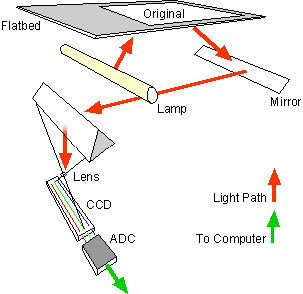A scanner is a device that captures images from photographic prints, posters, magazine pages, and similar sources for computer editing and display. Scanners come in hand-held, feed-in, and flatbed types and for scanning black-and-white only, or color.
HOW SCANNERS WORK
Scanners operate by shining light at the object or document being digitized and
directing the reflected light (usually through a series of mirrors and lenses)
onto a photosensitive element. In most scanners, the sensing medium is an electronic,
light-sensing integrated circuit known as a charged coupled device (CCD).
Light-sensitive photosites arrayed along the CCD convert levels of brightness
into electronic signals that are then processed into a digital image.
A scanner consists of a flat transparent glass bed under which the CCD sensors, lamp, lenses, filters and also mirrors are fixed. The document has to be placed on the glass bed. There will also be a cover to close the scanner. This cover may either be white or black in colour. This colour helps in providing uniformity in the background. This uniformity will help the scanner software to determine the size of the document to be scanned.
The lamp brightens up the text to be scanned. Most scanners use a cold cathode fluorescent lamp (CCFL).
 A stepper motor under the scanner moves the scanner head
from one end to the other. The movement will be slow and is controlled by a
belt. The scanner head consists of the mirrors, lens, CCD sensors and also the
filter. The scan head moves parallel to the glass bed and that too in a
constant path. As deviation may occur in its motion, a stabilizer bar will be
provided to compromise it. The scan head moves from one end of the machine to
the other. When it has reached the other end the scanning of the document has
been completed. For some scanners, a two way scan is used in which the scan
head has to reach its original position to ensure a complete scan.
A stepper motor under the scanner moves the scanner head
from one end to the other. The movement will be slow and is controlled by a
belt. The scanner head consists of the mirrors, lens, CCD sensors and also the
filter. The scan head moves parallel to the glass bed and that too in a
constant path. As deviation may occur in its motion, a stabilizer bar will be
provided to compromise it. The scan head moves from one end of the machine to
the other. When it has reached the other end the scanning of the document has
been completed. For some scanners, a two way scan is used in which the scan
head has to reach its original position to ensure a complete scan.
As the scan head moves under the glass bed, the light from the lamp hits the document and is reflected back with the help of mirrors angled to one another. According to the design of the device there may be either 2-way mirrors or 3-way mirrors. The mirrors will be angled in such a way that the reflected image will be hitting a smaller surface. In the end, the image will reach a lens which passes it through a filter and causes the image to be focussed on CCD sensors. The CCD sensors convert the light to electrical signals according to its intensity. Take a look at the diagram given below.
The electrical signals will be converted into image format inside a computer. This reception may also differ according to the variation in the lens and filter design. A method called three pass scanning is commonly used in which each movement of the scan head from one end to another uses each composite colour to be passed between the lens and the CCD sensors. After the three composite colours are scanned, the scanner software assembles the three filtered images into one single -colour image.